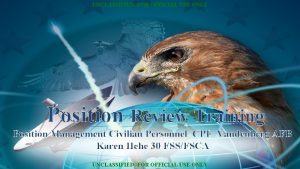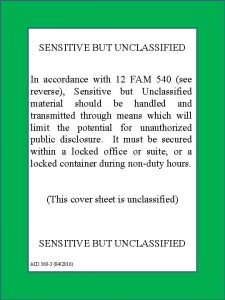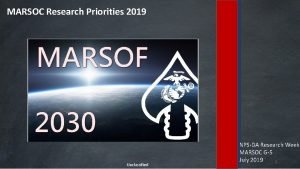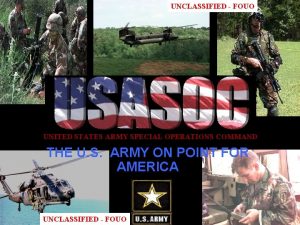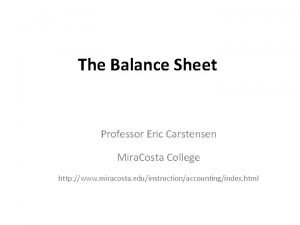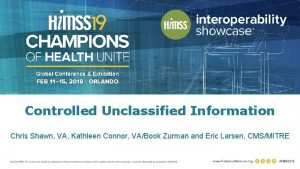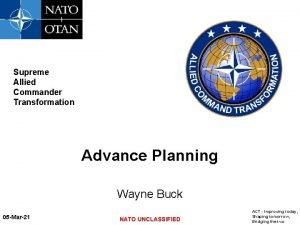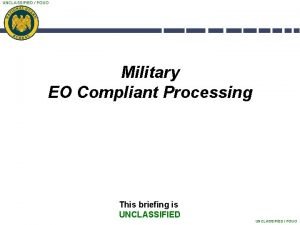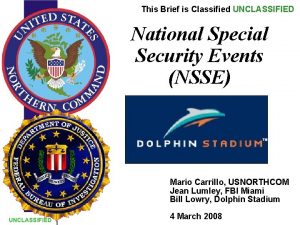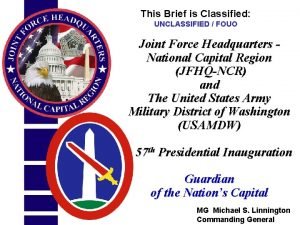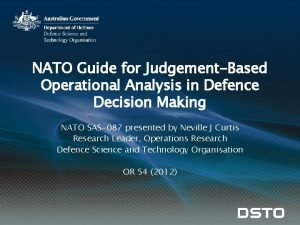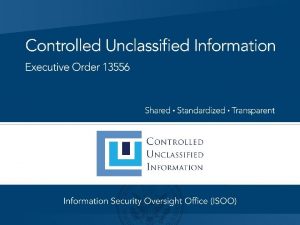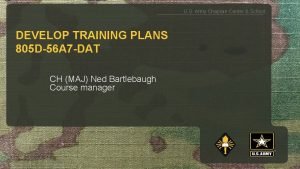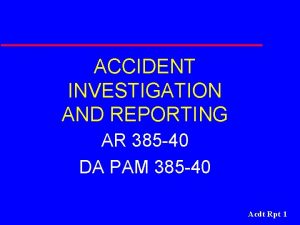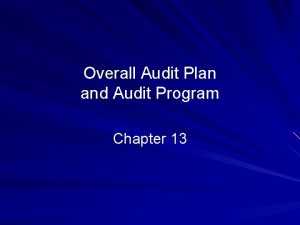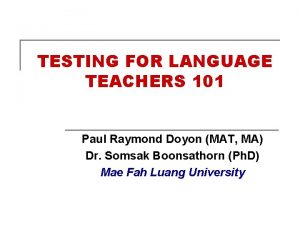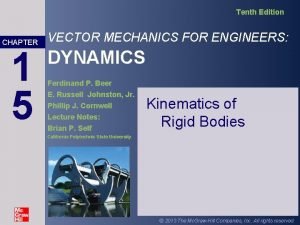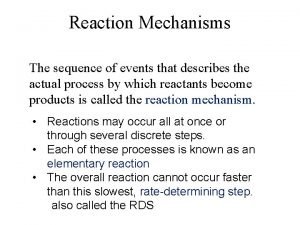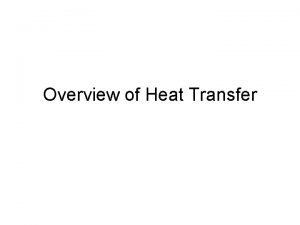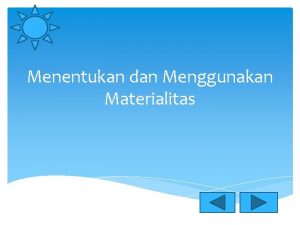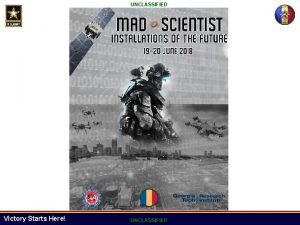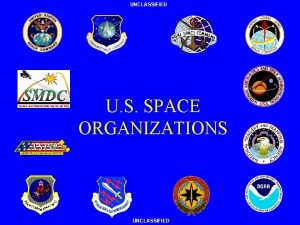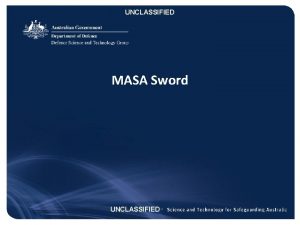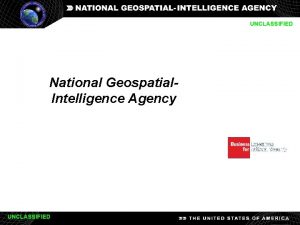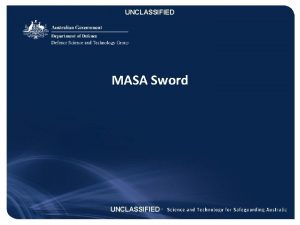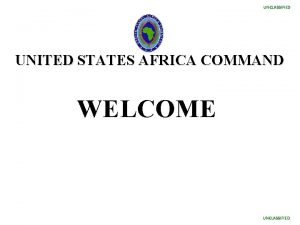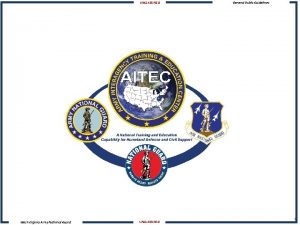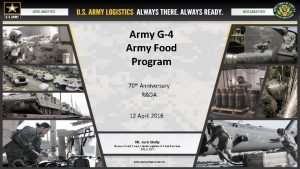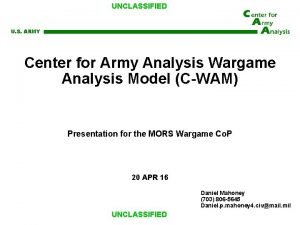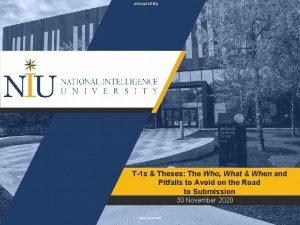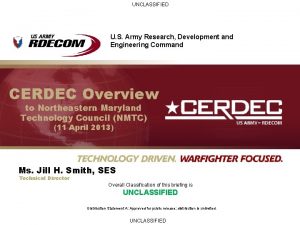Overall Classification is UNCLASSIFIED The Army and the

























- Slides: 25

Overall Classification is UNCLASSIFIED The Army and the 2010 QDR Foreign Military Attachés Army QDR Office February 2, 2010 Overall Classification is UNCLASSIFIED

Pop Quiz Do You Know Your Acronyms? • • QDR Do. D OSD IW SOF FCS DAWG Four or more right = you pass! UNCLASSIFIED 2

Purpose & Agenda Purpose Provide Foreign Military Attachés an update on the QDR process, the Army’s objectives for 2010 QDR, desired outcomes, and the final report. • • • Agenda QDR Legislation The QDR Report – What is it? 2009 Framework and Players Timeline & Milestones What it means to the Army Questions UNCLASSIFIED 3

QDR Legislation Potential Topics To Be Addressed in QDR Report (an example) Intent of Congress “The Secretary of Defense shall every four years, during a year following a year evenly divisible by four, conduct a comprehensive examination (to be known as a 'quadrennial defense review') of the national defense strategy, force structure, force modernization plans, infrastructure, budget plan, and other elements of the defense program and policies of the United States with a view toward determining and expressing the defense strategy of the United States and establishing a defense program for the next 20 years. Each such quadrennial defense review shall be conducted in consultation with the Chairman of the Joint Chiefs of Staff. ” 1. Strategy & force structure • Best suited • Low-to-moderate risk 2. National security interests 3. Threats & scenarios 4. Assumptions 5. Effects of Operations Other Than War & Small Scale Contingencies on high-intensity combat 6. Manpower & sustainment needed for conflicts lasting more than 120 days 7. Reserve Component roles & missions 8. Tooth-to-Tail ratio • Size & number of HQ and Defense Agencies 9. Specific Capabilities and Platforms needed 10. Lift required • Strategic & tactical airlift • Sealift • Ground transportation 11. Required forward presence & prepositioning 12. Inter-theater resource shifting 13. Unified Command Plan revisions 14. Effect on force structure of technologies • Anticipated over next 20 years 15. National defense mission of Coast Guard 16. Homeland Defense and Civil Support missions • Active and Reserve Component 17. Any other matter Secretary deems appropriate QDR Report due to Congress early Feb 2010, when the President submits his first budget. 4

What is a QDR? A comprehensive, strategic review from defense strategy to budget and programs for the next 20 years. National Security Strategy National Defense Strategy Other Inputs (not exhaustive) • Planning Scenarios & Vignettes • Operational Availability Studies • Base Realignment and Closure • Army Campaign Plan • Army Strategic Planning Guidance • Army Posture Statement • OIF/OEF and other contingencies National Military Strategy The effort is inherently political, rather than military. Ø Led by our appointed officials Ø Reflects the President’s priorities & Sec. Def’s thinking Ø Services participate but don’t lead it UNCLASSIFIED 5

QDR Process What it is: What it isn’t: • The Secretary of Defense’s strategy & direction for the Armed Forces for the next 20 years • Identification of “leading edge investments” • The Secretary of Defense’s objectives & priorities (top-down direction) • Comprehensive list of decisions • Programmatic or budget guidance • A consensus document (bottom -up process) or a compilation of Service / Agency quadrennial defense reviews Strategy Resources UNCLASSIFIED 6

Predecessors and Previous Reviews Pre-QDR Major Reviews • 1990 Base Force Review • 1993 Bottom-Up Review • 1995 Commission on Roles & Missions QDR 2006 • Four priority focus areas: • • Defeating terrorist networks; Defending the homeland in depth; Shaping the choices of countries at strategic crossroads; Preventing hostile states and non-state actors from acquiring or using WMD • Three objective areas: QDR 1997 • “Shape, Prepare, Respond” • “… deter and defeat large-scale, crossborder aggression in two distant theaters in overlapping time frames …” QDR 2001 • “Assure, Dissuade, Deter, Defeat” • Strategic Tenets: Managing Risks, Capabilities-Based Approach, etc. • Force Sizing Construct: “ 1 -4 -2 -1” • Homeland Defense • War on Terror / Irregular (Asymmetric) Warfare • Conventional Campaigns • Steady State and Surge operations capability needs Shifting our weight … 7

Previous QDRs • 1997 • Focus: Increasing Do. D procurement account to $60 B • Directed military and civilian endstrength reductions • 2001 • Focus: Disentangling military forces from peacekeeping and nationbuilding operations, skip a generation of modernization, space, missile defense, SOF, precision munitions • Army to lose 2 Regular, 4 National Guard divisions…until 9/11 • Homeland defense elevated, but “shock and awe” remained • 2005 • Focus: Balancing capability portfolios to address traditional, irregular, disruptive, and catastrophic challenges • Paid OSD passback in Oct 05 (Army = $11. 7 B) • Rotation base/objectives, grow SOF, modularize Army, operationalize and fully man/equip/train Reserve Component 8

Quadrennial Roles & Missions Review • Congressionally directed, every 4 years starting in 2008 – Conducted year before each QDR, – First report submitted Jan 2009 • Goal: Improve the effectiveness of joint, interagency operations • Report limited in scope – Irregular warfare, Cyberspace, Intra-Theater airlift, Unmanned air systems/ISR, Interagency opportunities • Results: – No significant changes to Roles & Missions included – Affirmed both SOF & GPF have significant IW responsibilities – Joint Cargo Aircraft (C 27 J) assigned to Army, AF for time sensitive/mission critical transport 9

Political Context of QDR 09 • On-going wars • A new administration, but with influential Secretary of Defense staying on • Flat or declining defense budgets forecast Ø Jun 08 National Defense Strategy cited as foundational QDR document— emphasizes alliances (partnerships) and engagement Ø Jan 09 SECDEF “Foreign Affairs” article lays out near-term agenda— must balance requirements to win the current fight and prepare for an uncertain future UNCLASSIFIED 10

Organization/Oversight NSC Review Sec. Def CJCS DSLC (SLRG* at milestones) DSD VCJCS Deputy’s Advisory Working Group Service Under Secs & Vices, VCJCS, COCOM Reps Core Group Individual outreach, pre-briefs, etc. PDUSD(P) Hon Miller QDR Advisory Group Strategy Review IPC (DHS, Intel, DOS, AID, NSC) DD, PA&E DJ-5 DJ-8 Lt. Gen Gardner VADM Winnefeld VADM Stanley QDR Stakeholders 3 -Star Level Service 5 s & 8 s, OSD/JS & COCOM Reps Integration Group: DUSD(SPF) OUSD(C) Ms. Hicks Robert Hale DDJ-5(S&P) Eric Coulter DDFM/J-8 RADM (Sel) Roberti Ms. Disbrow UNCLASSIFIED 11

QDR Players • QDR to be conducted “in consultation with the Chairman of the Joint Chiefs of Staff. ” • Each Service staffs a QDR Office to support the effort • Combatant Commanders participate in Senior Leader forums • Time-intensive meeting framework for Senior Leaders: • • • Deputies Advisory Working Group Small Group Large Group • USD(P) Hon. Michèle Flournoy directed that QDR 09 effort integrate with: • • • Other federal agencies Department of State is initiating a Congressional committees “Quadrennial Diplomacy and Department of Homeland Defense Development Review” Allies & partners Non-Government Organizations, Think Tanks, universities, and the private sector Ongoing Ballistic Missile Defense, Space Posture, and Nuclear Posture reviews …no feedback from OSD on whether this happened in a substantial way UNCLASSIFIED 12

QDR 09 Milestones Terms of Reference - 24 Apr 09 FY 10 Budget Announcement - 6 Apr 09 Sec. Def guidance for QDR 09 Three principles 1. Sustain All-Volunteer Force 2. Rebalance programs 3. Reform acquisition Sec. Def Gates QDR Five “Issue Teams” Important Program Decisions, (examples) 1. Restructure FCS 2. Terminate F-22 3. Delay some shipbuilding Guidance for Development of the Force February 2010 Draft Copy Report Dec 09 -Updated 28 Jul 09 - Incorporated early insights from the QDR to direct Service POMs -calls for specific initiatives in all QDR areas Program Budget Review, Sep - Oct -Does the Budget reflect the Guidance? - Other ideas? UNCLASSIFIED Issue Areas Outlined 1. Irregular warfare 2. High-end, asymmetric threats 3. Civil support at home 4. Global posture 5. Business practices “Cross-cutting” Efforts 1. Cyber, Information Operations, Intelligence, Surveillance and Reconnaissance (ISR) 2. Ongoing OSD Reviews: NPR, BMDR, SPR, May – September • Issue Teams work • Scenario-based exercises • Progress reviews to senior leaders 13

Goals of the Army • An Army that can: • • • Prevail in today’s war and future campaigns against terrorism Assist others in building their capacity to counter insurgencies or terrorists operating in their lands Support civil authorities, at home and abroad Deter and/or defeat hybrid threats and hostile state actors GEN George W. Casey, Jr. , Chief of Staff of the Army Our goal is to build a versatile mix of tailorable and networked organizations, operating on a rotational cycle, to provide a sustained flow of trained and ready forces for current commitments and to hedge against unexpected contingencies at a sustainable tempo for our all-volunteer force. UNCLASSIFIED 14

has Mullen, ADM become a. Joint world-class Force Quarterly, counterinsurgency 1 st Qtr, force FY 09 in an extraordinary short time. ” 2001: • Division-centric • Brigades contained only infantry or armor battalions – all enablers came from Division or higher HQs • • • 60 percent heavy RC organized, trained, and equipped as a strategic reserve Optimized for conventional conflict Army Adaptation 2009: • Brigade-centric • Modular brigade combat teams of combined arms – can accept additional enablers, as needed for the mission • 65 percent light • Operationalizing the RC • Full spectrum force – including additional emphasis on IW “Our Army has become a world-class counterinsurgency force in an extraordinarily short time” -ADM Mullen, Joint Force Quarterly, 1 st Qtr, FY 09 15

Army’s Desired QDR Outcomes • Agreement on the Strategic Environment / Future • What is the strategy to meet the environment? • What are the Army capabilities required to meet the strategy? • Homeland Defense & Civil Support – Dedicated Forces or Contingency? • Major Combat Operations vs Irregular Warfare • Multi-Purpose Forces vs Specialized Forces • How do we sustain the All Volunteer Force? • Sized to meet the strategy and expected demand? • Operating on a sustainable rotation cycle? • Quality of life for Soldiers & Families…care for the wounded. • Modernization vs. Resetting the Current Force UNCLASSIFIED Army sees environment of “persistent conflict; ” but common view needed across Do. D Demand is exceeding supply; Army is under stress and out of balance Sustained National commitment needed—it’s not just an “Army issue” 16

What Did the Army Do? Ø Army 101 papers ( JAN/JUL 09) Ø Various OSD ‘table top’ exercises (APR – OCT) Ø QDR Terms of Reference (TOR) (APR 09) ü ARSTAF GO/SES leads for key issue teams Ø Former Brigade Commander Seminars (4) (MAY – AUG 09) ü Select OSD senior leaders Ø MG Lennox from G 3 to G 8 AQDRO (MAY) Ø Army – SOCOM Staff talks (JUN) Ø Army Trips – NSA, Bragg, Bliss, Polk (MAY-AUG) ü Select OSD senior leaders Ø GDF update – SA/CSA Implementation Memo (JUL) Ø CCMRF NORTHCOM/ARNORTH validation exercises (AUG, NOV) Ø Draft copy of QDR staffed (DEC 09) 17

2010 QDR Report - Summary • The 2010 QDR – the Department’s fourth QDR – provided multiple opportunities to exchange and investigate new ideas and assess our plans, programs, and priorities. The Department will be better as a result of this QDR. • As with all QDRs, the 2010 QDR was led by the Sec. Def and Dep. Sec. Def, and reflects their vision and priorities. They led a continuous dialogue over the past several months that relooked all aspects of the Department, from strategy to budget, and everything in between. The senior leadership of the Army participated fully throughout the 2010 QDR. We support the Secretary’s findings and recommendations. • Of note for the Army, the 2010 QDR recognizes the significant strain borne by Soldiers and Army Families, and our collective imperative to preserve and enhance the All. Volunteer Force. • The 2010 QDR supports the need for ready forces rotating at sustainable rates and with sufficient time at home station between deployments, and recognizes the important contributions of our Reserve Components at home and abroad. • When implemented, the recommendations of the 2010 QDR will enhance our capabilities for the wars we are in and the challenges we are likely to face in the future, continue to adapt of our institutions for the 21 st Century, and preserve and enhance the All-Volunteer Force. UNCLASSIFIED 18

Objectives and Missions • Defense Focus: rebalance capabilities to ensure success in today’s wars and institutional reform. • April FY 10 Budget decisions, including Future Combat Systems (FCS) restructure and F-22 production, used to create fiscal trade space for QDR decisions. • Defense key missions: • Defense objectives: ü Prevail in Today’s Wars ü Homeland Defense ü Prevent and Deter Conflict ü Prepare for a Wide Range of Conflict ü Preserve the All Volunteer Force ü Stability/COIN/Counter-terrorism ü Building Partner Capacity ü Anti-Access Environments ü WMD ü Cyber • Defense Force planning: Prevail in current fight. Range of future challenges includes two major theater wars, but the 2 MTW construct is insufficient by itself to define required force capabilities and capacity. • Army Force structure Changes: Increases in rotary wing lift, SOF enablers, unmanned airborne ISR, Civil Affairs, Heavy to Stryker BCT, and 15 -22 k temporary end-strength. 19

2010 QDR – Key Army Outcomes § Recognizes rotational readiness model and near-term planning objective of 1: 2 and 1: 5 for AC and RC forces, respectively § Increases capacity of rotary-wing lift assets § Expands manned and unmanned aerial systems for ISR § Converts one HBCT to SBCT, with potential for more conversions § Retains four BCTs and Army Corps HQ in Europe, pending posture review § Increases key enablers for SOF § Institutionalizes general purpose force capabilities for Security Force Assistance (SFA) § Restructures domestic CBRNE consequence management response forces § Enhances regional, language, and cultural skills/capabilities § Establishes a standing JTF WMD Elimination capability § Establishes Service Component Commands to support USCYBERCOM § Describes requirement for an operational RC as well as strategic reserve UNCLASSIFIED 20

Ideas That Weren’t Accepted • A permanent “Advisory Corps” (up to 20, 000) to train foreign military forces • A “dual force” – one focused on IW/SFA and one on high-end conventional ops • Reduction in Army end-strength to pay for highend armaments • A range of redesign ideas for BCTs and support brigades • A “division of labor” force planning concept, orienting USAF and Navy on “conventional” war and Army on IW • “Fenced” forces for support to civil authorities “Given limited resources, the best option is to create a “Dual‐Surge” Full‐Spectrum‐Capable Force comprising BCTs oriented primarily—but not exclusively—on traditional or irregular warfare. ” Sometimes, the important thing is what doesn’t happen 21

Post-2010 QDR Report Events 2 Feb 10 CSIS Seminar (2010 QDR – An In-Depth Initial Appraisal) 2 Feb 10 GAO audit of 2010 QDR (entrance briefing) 2 Feb 10 Council on Foreign Relations (2010 QDR Report) 4 Feb 10 HASC (Testimony on 2009 QDR) 8 -9 Feb 10 NDU Symposium (2010 QDR: Implementing the New Path for America’s Defense) 17 -18 Feb 10 Aviation Week Defense Technology & Requirements Seminar (Leading the Next Generation of Defense Strategy and Procurement) 1 -4 Mar 10 MORS Workshop (Analytic Agenda: Post-QDR Way Ahead) Feb – Aug 10 Independent Review of 2010 QDR The 2010 QDR continues! 22

QDR 2009 Timeline OCT NOV DEC JAN FEB MAR $ MAY JUN JUL AUG SEP FY 07 Pres. Bud to Congress Federal Elections APR Develop GDF 10 -15 36 th CSA QDR 06 Implementation OA-07 Rpt $ Pres. Bud to Congress GDF 10 -15 OA-08 FY 08 Expand Army QDR Ofc w/ DMOs GDF FY 10 -15 Pre-QDR Research & Outreach Quadrennial Roles & Missions Review OA-08 Rpt Presidential Election $ Pres. Bud to Congress Inauguration Transition R&M Rpt $ Pres. Bud to Congress GDF 12 -17 QDR 09 RMD 702 We are here today FY 09 QDR 09 Rpt Develop GDF 12 -17 QDR TOR QDR 09 Development OA-09 GDF update FY 10 GDF FY 12 -17 QDR 09 Implementation 23

Closing Thought “Every gun that is made, every warship launched, every rocket fired, signifies in the final sense a theft from those who hunger and are not fed, those who are cold and are not clothed. ” President Dwight D. Eisenhower April 16, 1953 UNCLASSIFIED 24

“Never. . . was so much owed by so many to so few. ” Winston Churchill 20 August 1940 The American Soldier
 Unclassified position
Unclassified position Sbu/noforn
Sbu/noforn Npsda
Npsda Unclassified fouo
Unclassified fouo Statement of financial position account form
Statement of financial position account form Controlled unclassified information examples
Controlled unclassified information examples Scif prohibited items list
Scif prohibited items list Nato unclassified
Nato unclassified Ngr 600-22
Ngr 600-22 National special security event list
National special security event list Unclassified/fouo
Unclassified/fouo Nato unclassified
Nato unclassified Cui
Cui Us army chaplain center and school
Us army chaplain center and school Army ground accident report
Army ground accident report Themes in romeo and juliet
Themes in romeo and juliet Overall audit plan and audit program
Overall audit plan and audit program Manifold classification in statistics example
Manifold classification in statistics example Write the overall equation for photosynthesis using words
Write the overall equation for photosynthesis using words Purpose of discussion
Purpose of discussion Citric acid cycle overall reaction
Citric acid cycle overall reaction Testing overall ability
Testing overall ability At the instant shown the length of the boom ab
At the instant shown the length of the boom ab Molecularity of reaction
Molecularity of reaction The overall heat transfer coefficient
The overall heat transfer coefficient Overall materiality adalah
Overall materiality adalah
